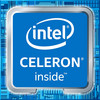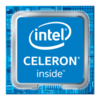Intel Celeron J3355 vs Intel Celeron N5095 vs Intel Celeron J3455
Intel Celeron J3355
► remove from comparison
The Intel Celeron J3355 is a dual-core SoC primarily for inexpensive notebooks and was announced in late 2016. It runs at 2 - 2.5 GHz (Single Core Burst) and is based on the Apollo Lake platform. Similar to the Braswell predecessor, the chip is manufactured in a 14 nm process (P1273) with FinFETs. Besides two CPU cores, the chip also includes a DirectX 12 capable GPU as well as a DDR3L/LPDDR3/LPDDR4 memory controller (dual-channel, up to 1866/2400 MHz).
Architecture
For the first time in a couple of years, Intel completely reworked the CPU architecture of the Atom series. The manufacturer advertises performance gains of roughly 30 percent, but does not reveal any specifics about the individual changes. The new Goldmont architecture should therefore be roughly on par with AMD's Beema/Carrizo-L APUs in terms of per-MHz performance, but it still far behind the more expensive Core CPUs (like Skylake / Kaby Lake).
Performance
The CPU performance of the Celeron J3355 is slightly better than the lower power Celeron N3350 and less depending on the cooling solution. This means the processor is only suited for light daily tasks (office, browsing).
GPU Performance
The HD Graphics 500 (Apollo Lake) is based on Intel's Gen9 architecture, which supports DirectX 12 and is also used for the Kaby Lake / Skylake graphics adapters (like HD Graphics 520). Equipped with 12 EUs and a clock of up to 700 MHz, the performance should be roughly on par with the older HD Graphics (Braswell). This means only older and simpler titles will run smoothly.
The chip also includes an advanced video engine with hardware support for the playback of VP9 and H.265 material (8-bit color-depth).
Power Consumption
The Celeron J3355 is specified at 10 Watt TDP and therefore 4 Watts higher than the slightly slower Celeron N3350.
Intel Celeron N5095
► remove from comparison
The Celeron N5095 is an inexpensive quad-core SoC of the Jasper Lake product family designed for use in affordable SFF desktops and laptops. It features four Tremont CPU cores running at 2 GHz that Boost to up to 2.9 GHz with no thread-doubling Hyper-Threading technology in sight. A pretty basic iGPU is present as well.
The only difference between the N5095 and the N5095A is that the latter comes with support for more proprietary Intel technologies such as the Smart Sound DSP, Wake on Voice and HD Audio.
Architecture and Features
Tremont brings many improvements over Goldmont Plus, the architecture that we know from the N5030 and myriads of other N-class CPUs. An up to 30% boost in single-thread performance is to be expected thanks to smarter prefetchers, branch prediction improvements and other refinements, according to Intel. These new chips are physically larger than their immediate predecessors as a result. Either way, this is still a "small" core rather than a "big" one according to ChipsAndCheese.
The Celeron has 1.5 MB of L2 and 4 MB of L3 cache and is compatible with DDR4-2933 and LPDDR4x-2933 memory or slower. Support for Intel CNVi Wi-Fi 6 modules is baked into the chip, as are 8 PCIe 3.0 lanes for NVMe SSD speeds up to 3.9 GB/s. USB 4 or Thunderbolt aren't supported however.
Please also note that the Celeron gets soldered to the motherboard (BGA1338 socket interface) for good and is thus not user-replaceable.
Performance
The average N5095 in our database is about as fast as the Core i3-10110U, Core i3-1005G1, Celeron N5105 and also the Ryzen 3 3200U in multi-threaded workloads. Which is just enough for the most basic of tasks in late 2024.
Performance will get a significant hit if the power target is set to 10 W or 6 W instead of the Intel-recommended 15 W value.
Graphics
The DirectX 12.1-capable 16 EU UHD Graphics runs at up to 750 MHz and is in many respects similar to what Ice Lake CPUs come equipped with. This graphics adapter is capable of driving up to 3 SUHD displays simultaneously; HEVC, AVC, VP9, MPEG-2 and other popular video codecs can all be hardware-decoded. AV1 and VVC can't.
As far as gaming is concerned, it is reasonable to expect playable framerates in really old games (like Dota 2 Reborn) provided one sticks to lower resolutions such as HD 720p.
Power consumption
While most N-class chips have a 6 W long-term power target, the Celeron N5095 has a 15 W TDP to mimic much faster U-class Core processors. This isn't a great CPU for passively cooled designs.
The N5095 is built with the same 10 nm Intel process as Ice Lake-U processors for pretty unimpressive power efficiency, as of late 2024.
Intel Celeron J3455
► remove from comparison
The Intel Celeron J3355 is a quad-core SoC primarily for inexpensive notebooks and Mini-PCs and was announced in late 2016. It runs at 1.5 - 2.3 GHz (Single Core Burst) and is based on the Apollo Lake platform. Similar to the Braswell predecessor, the chip is manufactured in a 14 nm process (P1273) with FinFETs. Besides two CPU cores, the chip also includes a DirectX 12 capable GPU as well as a DDR3L/LPDDR3/LPDDR4 memory controller (dual-channel, up to 1866/2400 MHz).
Architecture
For the first time in a couple of years, Intel completely reworked the CPU architecture of the Atom series. The manufacturer advertises performance gains of roughly 30 percent, but does not reveal any specifics about the individual changes. The new Goldmont architecture should therefore be roughly on par with AMD's Beema/Carrizo-L APUs in terms of per-MHz performance, but it still far behind the more expensive Core CPUs (like Skylake / Kaby Lake).
Performance
The CPU performance of the Celeron J3455 is between the mobile Celeron N3450 and Pentium N4200 in the lower range of mobile processors. Therefore, the CPU is best suited for light tasks with not much multitasking (office, browsing).
GPU Performance
The HD Graphics 500 (Apollo Lake) is based on Intel's Gen9 architecture, which supports DirectX 12 and is also used for the Kaby Lake / Skylake graphics adapters (like HD Graphics 520). Equipped with 12 EUs and a clock of up to 750 MHz, the performance should be roughly on par with the older HD Graphics (Braswell). This means only older and simpler titles will run smoothly.
The chip also includes an advanced video engine with hardware support for the playback of VP9 and H.265 material (8-bit color-depth).
Power Consumption
The Celeron J3455 is specified at 10 Watt TDP and therefore 4 Watts higher than the slightly faster Pentium N4200.
| Model | Intel Celeron J3355 | Intel Celeron N5095 | Intel Celeron J3455 | ||||||||||||||||||||||||||||||||||||||||||||||||||||||||||||||||
| Codename | Apollo Lake | Jasper Lake | Apollo Lake | ||||||||||||||||||||||||||||||||||||||||||||||||||||||||||||||||
| Series | Intel Celeron | Intel Jasper Lake | Intel Celeron | ||||||||||||||||||||||||||||||||||||||||||||||||||||||||||||||||
| Series: Celeron Apollo Lake |
|
|
| ||||||||||||||||||||||||||||||||||||||||||||||||||||||||||||||||
| Clock | 2000 - 2500 MHz | 2000 - 2900 MHz | 1500 - 2300 MHz | ||||||||||||||||||||||||||||||||||||||||||||||||||||||||||||||||
| L2 Cache | 2 MB | 1.5 MB | 2 MB | ||||||||||||||||||||||||||||||||||||||||||||||||||||||||||||||||
| Cores / Threads | 2 / 2 | 4 / 4 4 x 2.9 GHz Intel Tremont | 4 / 4 | ||||||||||||||||||||||||||||||||||||||||||||||||||||||||||||||||
| TDP | 10 Watt | 15 Watt | 10 Watt | ||||||||||||||||||||||||||||||||||||||||||||||||||||||||||||||||
| Technology | 14 nm | 10 nm | 14 nm | ||||||||||||||||||||||||||||||||||||||||||||||||||||||||||||||||
| max. Temp. | 105 °C | 105 °C | 105 °C | ||||||||||||||||||||||||||||||||||||||||||||||||||||||||||||||||
| Socket | FCBGA1296 | BGA1338 | FCBGA1296 | ||||||||||||||||||||||||||||||||||||||||||||||||||||||||||||||||
| Features | Intel HD Graphics 500 (12 EUs, 200 - 700 MHz), Quick Sync, AES-NI, max. 8 GB Dual-Channel DDR3L-1866/LPDDR3-1866/LPDDR4-2400 , 8x USB 3.0, 6x PCIe 2.0, 2x SATA 6.0 Gbit/s | DDR4-2933/LPDDR4x-2933 RAM, PCIe 3, GNA, MMX, SSE, SSE2, SSE3, SSSE3, SSE4.1, SSE4.2, VMX, SMEP, SMAP, EIST, TM1, TM2, Turbo, SST, AES-NI, RDRAND, RDSEED, SHA | Intel HD Graphics 500 (12 EUs, 200 - 750 MHz), Quick Sync, AES-NI, max. 8 GB Dual-Channel DDR3L-1866/LPDDR3-1866/LPDDR4-2400 , 8x USB 3.0, 6x PCIe 2.0, 2x SATA 6.0 Gbit/s | ||||||||||||||||||||||||||||||||||||||||||||||||||||||||||||||||
| iGPU | Intel HD Graphics 500 (250 - 700 MHz) | Intel UHD Graphics (Jasper Lake 16 EU) (450 - 750 MHz) | Intel HD Graphics 500 (250 - 750 MHz) | ||||||||||||||||||||||||||||||||||||||||||||||||||||||||||||||||
| Architecture | x86 | x86 | x86 | ||||||||||||||||||||||||||||||||||||||||||||||||||||||||||||||||
| $107 U.S. | $107 U.S. | ||||||||||||||||||||||||||||||||||||||||||||||||||||||||||||||||||
| Announced | |||||||||||||||||||||||||||||||||||||||||||||||||||||||||||||||||||
| Manufacturer | ark.intel.com | ark.intel.com | ark.intel.com | ||||||||||||||||||||||||||||||||||||||||||||||||||||||||||||||||
| L3 Cache | 4 MB |
Benchmarks
Average Benchmarks Intel Celeron J3355 → 0% n=0
Average Benchmarks Intel Celeron N5095 → 0% n=0
Average Benchmarks Intel Celeron J3455 → 0% n=0
* Smaller numbers mean a higher performance
1 This benchmark is not used for the average calculation













